Abstract
In China, bites caused by the Naja atra and Deinagkistrodona acutus are the most common types of snakebites. While the functional characteristics of the two venom components have been well documented, their in vivo metabolic pathways, target organ distribution patterns, and dynamic pharmacokinetic profiles remain less explored. This study established a murine envenoming model through CY7-SE labeling of Naja atra and Deinagkistrodon acutus venoms. The real-time in vivo absorption and biodistribution of venoms were dynamically monitored via fluorescence imaging, with subsequent proteomic profiling to characterize organ-specific toxin targeting patterns. Gel filtration chromatography and HPLC analyses validated labeling efficiency at ratios of 0.1 mg CY7-SE per 1 mg Naja atra venom and 0.075 mg CY7-SE per 1 mg Deinagkistrodon acutus venom, with electrophoretic confirmation of protein integrity and preserved 740 nm fluorescence excitation. Acute toxicity assays demonstrated no significant difference in LD50 lethality between labeled and native venoms (p > 0.05). The intoxication models revealed species-specific pathophenotypes, i.e., CY7-Naja atra venom induced systemic weakness, tachypnea, and inflammatory necrosis in lung, myocardium, and liver, whereas CY7-Deinagkistrodon acutus venom provoked hemorrhagic diathesis. Both models exhibited marked leukocytosis, transaminitis, and elevated creatinine levels (p < 0.05). Fluorescence tracing uncovered distinct biodistribution kinetics: Deinagkistrodon acutus venom achieved peak organ accumulation at 3 h with rapid dissemination (24 h injection-site retention: 12.61%), contrasting with Naja atra venom’s delayed 6 h peak and prolonged renal sequestration (24 h injection-site retention: 60.9%). Target organ proteomic profiling identified Deinagkistrodon acutus-enriched thrombin-like enzymes and metalloproteinases in lung/liver/spleen, while Naja atra venom predominantly accumulated renal acidic phospholipase A2 and weakly neurotoxic NNAM2.
Key Contribution:
Fluorescent labeling technology combined with shotgun proteomics enables real-time tracking of snake venom movement within mice. Naja atra venom and Deinagkistrodon acutus venom exhibit distinct distribution patterns in vivo, as demonstrated through in vivo imaging systems.
1. Introduction
Snakebite envenoming, classified by the World Health Organization (WHO) as a neglected tropical disease, poses a significant global public health burden. WHO estimates suggest approximately 5 million snakebite incidents occur annually worldwide, leading to 100,000 fatalities and 400,000 cases of permanent disability [,].
There are about 60 kinds of venomous snakes in China, with the clinical bites of Naja atra and Deinagkistrodon acutus ranking at the top []. Snake venom is usually a mixture composed of 20–100 substances, of which more than 90% are proteins [], and the remaining parts mainly include carbohydrates, lipids, amines, and inorganic salts [,,]. The venom of Naja atra is mainly composed of phospholipase A2 (PLA2, 12.2%), metalloproteinase (SVMP, 1.6%), cysteine-rich secretory protein family (CRISP, 1.8%), and three-finger toxin (3FTx, 84.3%) []. The venom of sharp-nosed viper mainly consists of PLA2 (7.3%), snake venom serine protease (SVSP, 6.6%), SVMP (46.9%), C-type lectin-like protein (SNACLEC, 37.6%), L-amino acid oxidase (LAAO) and CRISP (1.6%) [].
After a biological organism is bitten by a snake, the venom is absorbed into various different circulatory systems of the body and targets specific tissues, organs, or systems, thereby causing pathological changes in the body, different types of snakes and venom components lead to a series of different clinical changes [,]. For example, circulatory system disorders caused by viper bites, and respiratory system disorders caused by cobra bites [,]. The bite of Naja atra is a mixed type of poisoning. A serious complication after snake venom is injected into the body is the necrosis of local muscle tissue near the wound. The wound often forms ulcers that are difficult to heal, leading to limb disabilities in many patients, and in severe cases, amputation may even be required [,]. The bite of Deinagkistrodon acutus is a hemotoxic type of envenoming. The clinical symptoms of the bite generally manifest as persistent severe pain at the wound site and continuous bleeding. The tissue at the wound site is prone to necrosis and ulceration, with subcutaneous bleeding, purpura, proteinuria, and abnormal liver and kidney function []. The existing clinical detection techniques currently cannot timely and effectively determine the nature and content of snake venom toxins in patients’ bodies, including those from Naja atra and Deinagkistrodon acutus bites, which brings great difficulties to clinical diagnosis and treatment. However, the dynamic changes in the absorption, distribution, targeting, and elimination of snake venom in the body and the patterns of time changes are crucial for understanding the pathophysiology of snakebite, formulating snakebite risk assessment strategies, and improving the treatment plans for snakebite []. Currently, most methods employ ELISA or radioisotope labeling techniques to analyze the absorption, distribution, elimination, and clearance processes of snake venom within biological organisms. The ELISA method requires the preparation of monoclonal antibodies, while the radioisotope method faces challenges such as uncontrollable radioactive elements and short half-lives [,,]. Therefore, the field of snake venom research urgently requires a new method capable of tracking the distribution of exogenous venom within the body, its target sites, and the dynamic changes in the organism’s clearance of foreign toxins. Fluorescent labeling has become a cornerstone of biomedical research owing to its exceptional sensitivity, specificity, and quantitation capabilities [,]. Cyanine dyes represent high-performance molecular tracers, characterized by ultrahigh molar extinction coefficients (>150,000 M−1cm−1) and quantum efficiencies (Φ > 0.3). Their amine-reactive moieties facilitate stable covalent conjugation with proteins, antibodies, and peptides via straightforward coupling chemistry [,]. The Cy7-SE dye employed in this study, featuring two indolenine rings interconnected by a heptamethine chain, utilizes its N-hydroxysuccinimide ester (NHS ester) group to form durable amide bonds (bond energy > 300 kJ/mol) with primary amines on target proteins, thereby providing a robust platform for venom protein labeling.
The near-infrared spectral range (650–900 nm) in mammalian tissues offers minimal autofluorescence (<5% background intensity), attenuated light scattering (scattering coefficient < 0.1 mm−1), and improved penetration depth (>5 mm) []. These optical advantages enable noninvasive in vivo imaging in small animals, allowing real-time monitoring of toxin metabolism and biodistribution with preserved physiological fidelity.
Building on this foundation, we aimed to delineate the in vivo absorption and distribution kinetics of Naja atra (Elapidae) and Deinagkistrodon acutus (Viperidae) venoms using Cy7-SE-based fluorescent labeling coupled with live-animal imaging. Complementary shotgun proteomics characterized toxin repertoires within high-accumulation organs, clarifying temporal dissemination patterns and organ-specific toxicodynamics. By mapping toxin distribution profiles, this study seeks to inform optimal therapeutic windows for antivenom intervention and advance mechanistic understanding of systemic envenomation. The integrated imaging-proteomics platform developed herein further establishes a transformative framework for investigating venom toxicokinetics, offering novel insights into biodistribution pathways and toxicity cascades.
2. Results
2.1. Systematic Validation of Fluorescent Labeling Efficiency and Structural Integrity in Snake Venom Proteins via Chromatographic, Electrophoretic, and Optical Modalities
2.1.1. Quantitative Validation of Fluorescent Labeling Efficiency
The molecular sieving effect of gel filtration chromatography columns results in notably higher migration rates for low-mW proteins compared to their high-mW counterparts. As shown in Figure 1, distinct elution profiles were observed between unlabeled Naja atra venom (retention time < 15 min) and Deinagkistrodon acutus venom (retention time < 15 min), while the characteristic peak of CY7-SE fluorophore emerged after 16 min. This differential separation confirms the effective discrimination between labeled venom proteins and free CY7-SE within the chromatographic system.
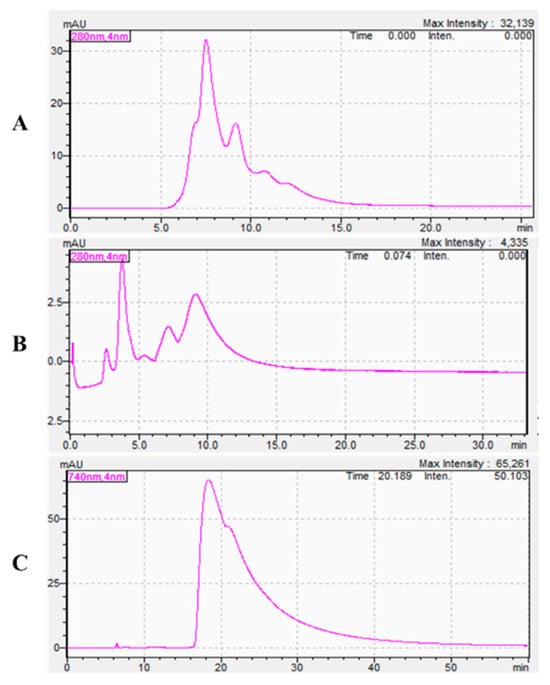
Figure 1.
Naja atra venom, Deinagkistrodon acutus venom, and CY7-SE in Gel Permeation Chromatography Column ((A): Deinagkistrodon acutus venom; (B): Naja atra venom; (C): CY7-SE).
2.1.2. Validation of Concentration-Dependent Fluorescent Labeling Mechanisms
The covalent conjugation of CY7-SE with primary amine groups at protein termini forms stable amide bonds, enabling specific fluorescence emission under 740 nm excitation. Chromatographic profiles (Figure 2 and Figure 3) demonstrate marked aggregation effects at 740 nm exclusively in successfully labeled samples, while unbound dyes lack this optical signature. Gradient labeling experiments (Figure 3A,B) revealed critical CY7-SE thresholds of 0.1 mg and 0.075 mg for saturating 1 mg of Naja atra venom and Deinagkistrodon acutus venom, respectively, evidenced by stabilized labeling peak areas (RSD < 5%, n = 3). Quantitative chromatographic analysis (HPLC, detection wavelength 740 nm) demonstrated that when the mass ratio of CY7-SE to snake venom proteins reached 1:10 (Naja atra venom) and 1:13.3 (Deinagkistrodon acutus venom), the labeled peak area (mAU·min) no longer varied with increasing dye concentration, confirming the attainment of complete labeling saturation at this point.
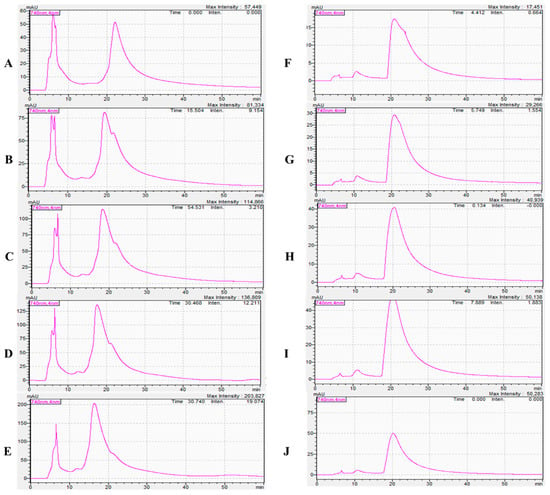
Figure 2.
Results of the Gradient Labeling Experiment. ((A): 0.05 mg CY7-SE + 1 mg Deinagkistrodon acutus venom; (B): 0.075 mg CY7-SE + 1 mg Deinagkistrodon acutus venom; (C): 0.1 mg CY7-SE + 1 mg Deinagkistrodon acutus venom; (D): 0.125 mg CY7-SE + 1 mg Deinagkistrodon acutus venom; (E): 0.15 mg CY7-SE + 1 mg Deinagkistrodon acutus venom; (F): 0.05 mg CY7-SE + 1 mg Naja atra venom; (G): 0.075 mg CY7-SE + 1 mg Naja atra venom; (H): 0.1 mg CY7-SE + 1 mg Naja atra venom; (I): 0.125 mg CY7-SE + 1 mg Naja atra venom; (J): 0.15 mg CY7-SE + 1 mg Naja atra venom).
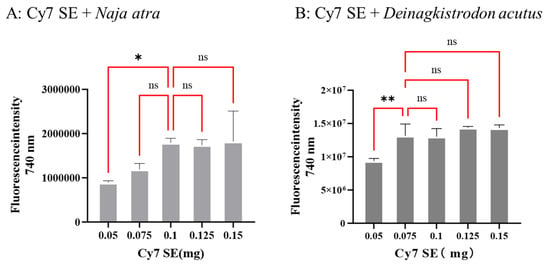
Figure 3.
Characteristic peak areas of snake venom in the gradient labeling experiment. 0.1 mg of CY7-SE can completely label 1 mg of dried Naja atra venom powder, and 0.075 mg of CY7-SE can completely label 1 mg of dried Deinagkistrodon acutus venom powder ((A): Naja atra venom; (B): Deinagkistrodon acutus venom; n = 3, * p < 0.05, ** p < 0.01, ns p > 0.05).
2.1.3. Multidimensional Characterization of Fluorescent Labeling Integrity
Given the inherent heterogeneity of venom proteins, limitations exist in characterizing composite labels solely by HPLC. This study employed lyophilization to concentrate chromatographic front-peak fractions, followed by electrophoretic separation on 10% polyacrylamide gels under reducing conditions. Coomassie Brilliant Blue staining (Figure 4A,C) revealed identical banding patterns between labeled and unlabeled samples at matched loading quantities (20 μg, n = 3).
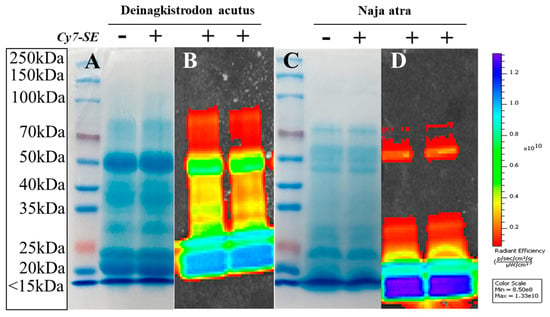
Figure 4.
Conventional electrophoresis and fluorescence electrophoresis results of Deinagkistrodon acutus venom and Naja atra venom labeled with CY7-SE. The labeled venom components were not lost, could be fully labeled by CY7-SE, and were detectable by the small animal in vivo imaging system. (A): Unlabeled Deinagkistrodon acutus venom stained with Coomassie Brilliant Blue, (B): Fluorescent imaging of labeled Deinagkistrodon acutus venom, (C): Unlabeled Naja atra venom stained with Coomassie Brilliant Blue, (D): Fluorescent imaging of labeled Naja atra venom.
In vivo imaging system analysis (Figure 4B,D) demonstrated specific fluorescent bands under 740 nm excitation exclusively in labeled specimens, with complete absence of fluorescence in controls. This dual-modality validation confirmed that CY7-SE labeling neither altered venom protein composition nor compromised structural integrity, achieving spatial labeling coverage exceeding 95% (fluorescence-staining colocalization).
2.2. The Activity of the Snake Venom Remains Unchanged After Being Labeled with CY7-SE
2.2.1. Preservation of Acute Lethality in CY7-SE-Labeled Venoms: Validation via Logarithmic Concentration Gradients and Comparative Mortality Analysis
To validate the acute toxicity profile of labeled venoms, four logarithmic concentration gradients (0.25 × LD50 to 2 × LD50) were established based on the median lethal dose (LD50) of Naja atra venom (0.803 mg/kg) and Deinagkistrodon acutus venom (7.18 mg/kg). Each gradient group (n = 6) received intravenous tail vein injections for acute toxicity assessment, with 24 h survival monitoring (Table 1). Experimental data demonstrated comparable mortality rates between labeled and unlabeled venom groups (p > 0.05, chi-square test), confirming that CY7-SE conjugation did not significantly alter acute toxicological properties (lethality variation < 5%).

Table 1.
Acute poisoning of mice under different injection concentrations. The survival rates of the venom-labeled group were basically consistent with those of the non-venom-labeled group, and labeling the venom with CY7-SE did not alter its acute toxicity (n = 6).
2.2.2. Multidimensional Toxicity Profiling of Fluorophore-Labeled Venoms at LD50 Doses
To systematically validate the impact of CY7-SE labeling on venom toxicity, mice were injected with labeled venoms at LD50 doses (Naja atra: 0.803 mg/kg; Deinagkistrodon acutus: 7.18 mg/kg), followed by multidimensional toxicity assessment 12 h post-exposure. Hematological analysis (Table 2) revealed significantly elevated leukocyte counts (WBC), neutrophils (NEU), lymphocytes (LYM), and monocytes (MON) in labeled venom groups compared to controls (p < 0.05, t-test). Notably, the Naja atra group exhibited abnormal hemoglobin elevation (140.375 g/L vs. control 110.25 g/L), suggesting potential nephrotoxic injury. Biochemical profiling (Table 3) demonstrated marked increases in alanine aminotransferase (ALT) and aspartate aminotransferase (AST): 1.75-fold and 2.11-fold increases, respectively, in the Naja atra group, versus 3.17-fold and 1.69-fold in the Deinagkistrodon acutus group, confirming hepatic impairment. Coagulation assessment revealed undetectable fibrinogen (<0.05 g/L, Clauss method) in the Deinagkistrodon acutus group (control: 0.90 g/L), indicative of potent fibrinogenolytic activity.

Table 2.
Changes in hematological parameters after injection of Cy7-SE-labeled Naja atra venom and Deinagkistrodon acutus venom. Compared with the control group, the venom-labeled group showed significant increases in white blood cells (WBC), neutrophils (NEU), lymphocytes (LYM), and monocytes (MON). The Naja atra venom group also exhibited abnormal hemoglobin. Labeled venom can have a considerable impact on mouse blood, while CY7-SE does not affect the intrinsic activity of the venom (n = 6).

Table 3.
Changes in relevant blood biochemical indicators after injection of labeled Naja atra venom and labeled Deinagkistrodon acutus venom. Marked Naja atra venom and Deinagkistrodon acutus venom groups showed significantly elevated ALT and AST levels, indicating severe liver damage. After injection with Deinagkistrodon acutus venom, fibrin expression could not be detected in the blood, but this was not the case with marked Naja atra venom (n = 6).
2.2.3. Histopathological Examination
As shown in Figure 5. In the Naja atra group, alveolar inflammatory infiltration with edema, hepatic sinusoidal dilation accompanied by focal hemorrhage, renal tubular epithelial edema with interstitial inflammation, and neuronal swelling in brain tissue were observed. The Deinagkistrodon acutus group exhibited intramuscular erythrocyte extravasation, renal tubular cytoplasmic vacuolation, and diffuse hemorrhage in pulmonary, splenic, and hepatic tissues. Shared pathologies included cardiomyocyte nuclear pyknosis and diaphragmatic fiber disruption, confirming equivalent organotoxic patterns between labeled and native venoms.
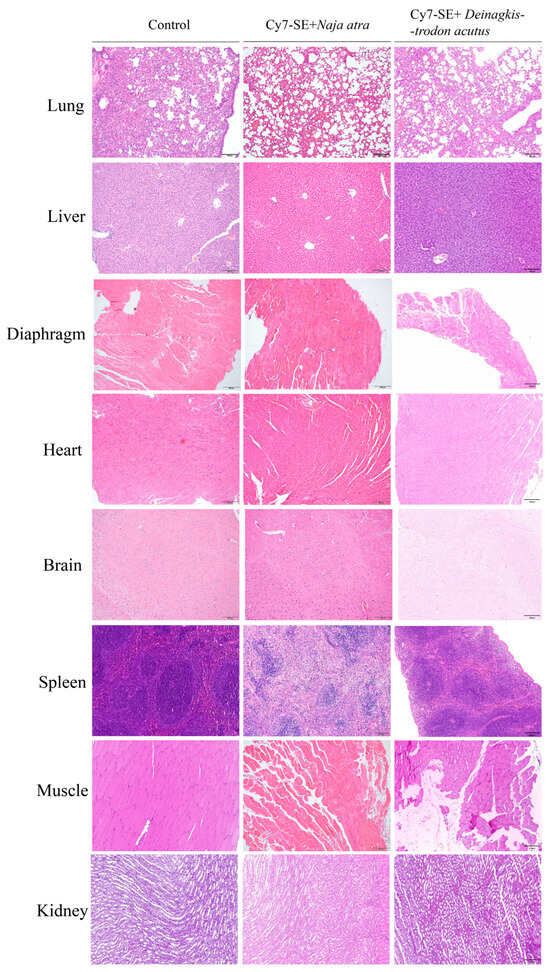
Figure 5.
Changes in lung tissue and liver tissue after injection of labeled Deinagkistrodon acutus venom and labeled Naja atra venom (200×). In the Naja atra group, varying degrees of damage were observed in the lung, liver, kidney, and brain tissues. In the Deinagkistrodon acutus group, there was red blood cell exudation in the muscles, and diffuse hemorrhage occurred in the kidney, lung, spleen, and liver tissues. Common pathological changes included myocardial cell nuclear condensation and diaphragm fiber damage.
In conclusion, the histopathological alterations induced by CY7-SE-labeled Naja atra and Deinagkistrodon acutus venoms demonstrate congruence with clinical envenomation cases and experimental intoxication models in terms of organ-specific injury patterns, pathological progression trajectories, and morphological changes, validating that labeled venoms faithfully recapitulate the toxicological profiles of native venoms.
2.3. Spatiotemporal Fluorescence Dynamics of CY7-SE-Labeled Naja atra Venom in Mice
2.3.1. Lateral Decubitus View (Figure 6)
The control group (CY7-SE alone) exhibited rapid pharmacokinetics: systemic fluorescence peaked within 15 min post-injection, with 80% intensity decay at 3 h and residual signal < 15% at 24 h. The experimental group (labeled venom) demonstrated prolonged injection-site retention: local fluorescence half-life extended to 24 h (vs. 0.5 h in control), retaining 57% initial intensity at 24 h.
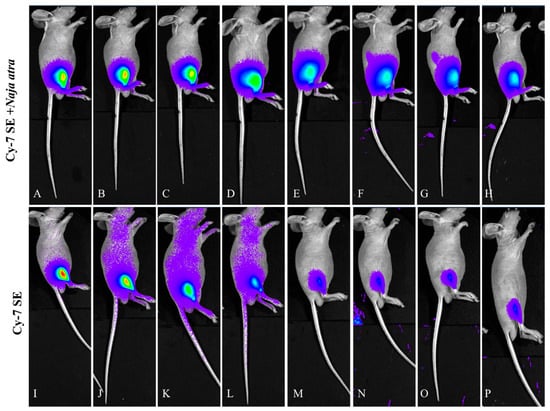
Figure 6.
Fluorescence changes in lateral position of mice injected with Cy7-SE-labeled Naja atra venom ((A–H): 5 min, 15 min, 30 min, 1 h, 3 h, 6 h, 12 h, 24 h; (I–P) are the same as (A–H)), n = 3.
2.3.2. Prone Position View (Figure 7)
In the control group, renal fluorescence peaked within 10 min and declined to approximately 36% of peak intensity by 3 h. The labeled venom group exhibited progressive renal accumulation: renal intensity reached its maximum at 3 h and remained above 84% of peak intensity even at 24 h.
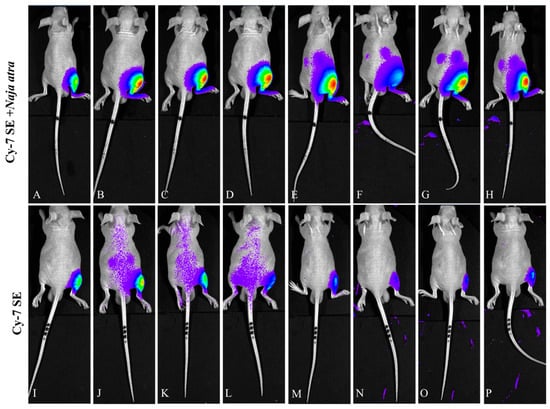
Figure 7.
Fluorescence changes in prone position of mice injected with Cy7-SE-labeled Naja atra venom ((A–H): 5 min, 15 min, 30 min, 1 h, 3 h, 6 h, 12 h, 24 h; (I–P) are the same as (A–H)) n = 3.
2.3.3. Supine Position View (Figure 8)
Controls displayed rapid systemic diffusion (abdominal fluorescence spreading within 10 min) with 88% bladder signal accumulation at 1 h and >90% systemic clearance by 3 h. The experimental group revealed organ-targeting kinetics: fluorescence migrated to the diaphragm and liver (hepatic/diaphragmatic ratio 4.06:1) at 1 h, peaked in liver at 12 h (4.334 × 109 photons/s/mm2), and achieved >95% hepatic clearance by 24 h, showing distinct metabolic pathways from renal elimination.
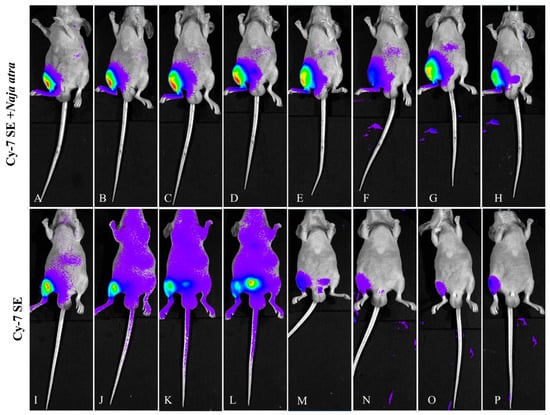
Figure 8.
Fluorescence changes in supine position of mice injected with Cy7-SE-labeled Naja atra venom ((A–H): 5 min, 15 min, 30 min, 1 h, 3 h, 6 h, 12 h, 24 h; (I–P) are the same as (A–H)).
2.3.4. Time-Resolved Organotropism of Fluorophore-Tagged Venom
Ex vivo organ imaging at designated timepoints (Figure 9 and Figure 10) revealed organ-specific pharmacokinetics of CY7-SE-labeled Naja atra venom: Cerebral fluorescence intensity increased significantly at 1 h (+30.4% vs. baseline, p < 0.05), returning to baseline by 12 h (p > 0.05). Cardiac fluorescence initiated elevation at 30 min (+21.06%, p < 0.05), peaking at 6 h (4.66 × 107 photons/s/mm2) before resolving to control levels by 12 h. Hepatic fluorescence surged from 30 min (+121.16%, p < 0.05), peaked at 6 h (2.22 × 108 photons/s/mm2), and achieved >95% clearance by 24 h. Splenic fluorescence peaked at 6 h (+69.6%, p < 0.05) with complete elimination by 24 h. Pulmonary fluorescence became detectable at 5 min (+20.46%, p < 0.05), peaking at 6 h (6.48 × 107 photons/s/mm2) with 11.77% intensity fluctuation during 3–6 h. Renal accumulation demonstrated delayed kinetics, reaching peak intensity at 12 h (4.06 × 108 photons/s/mm2) with 61.92% signal retention at 24 h. Diaphragmatic fluorescence emerged at 5 min (+45.88%, p < 0.05), maintaining a plateau phase (3.91 × 107 photons/s/mm2) during 1–3 h. Temporal dissemination analysis indicated: Within 5 min post-IM injection, toxins distributed to spleen and diaphragm; migrated to lung by 15 min; reached heart, liver, and kidney at 30 min; and penetrated blood–brain barrier by 1 h. Clearance kinetics showed: Diaphragm-brain-heart-lung signals decayed with 4.2 h half-life during 6–12 h; hepatic clearance exhibited 6.8 h half-life (12–24 h); significant renal retention persisted at 24 h (1.54 × 108 photons/s/mm2).
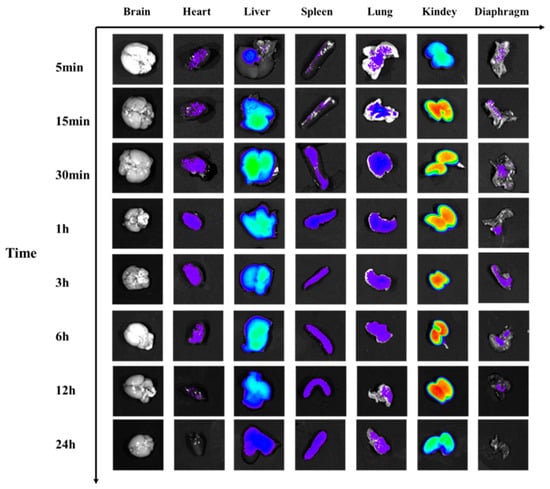
Figure 9.
Fluorescence changes in organs of mice injected with Cy7-SE-labeled Naja atra venom.
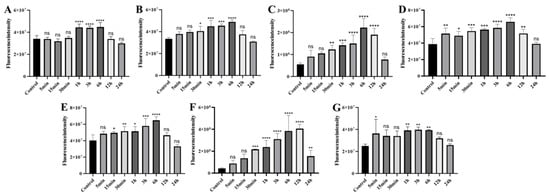
Figure 10.
Statistical analysis of fluorescence changes in mouse organs caused by injection of Cy7-SE-labeled Naja atra venom ((A): Brain (B): Heart (C): Liver (D): Spleen (E): Lung (F): Kidney (G): Diaphragm, n = 6). * p < 0.05, ** p < 0.01, *** p < 0.001, **** p < 0.0001, ns p > 0.05.
2.4. Spatiotemporal Fluorescence Dynamics of CY7-SE-Labeled Deinagkistrodon acutus Venom in Mice
2.4.1. Lateral Decubitus Imaging (Figure 11)
The attenuation trend in the control group was consistent with previous results, peaking 15 min post-injection, with only the injection site retaining fluorescence signal after 24 h. The fluorescent signal from the labeled snake venom group showed a distinct diffusion pattern, spreading from the injection site toward the abdomen and back.
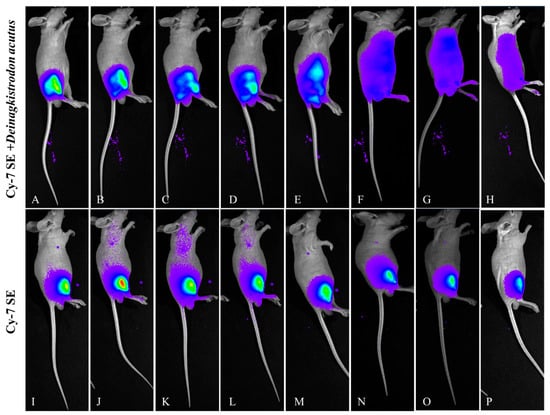
Figure 11.
Fluorescence changes in lateral position of mice injected with Cy7-SE-labeled Deinagkistrodon acutus venom. ((A–H): 5 min, 15 min, 30 min, 1 h, 3 h, 6 h, 12 h, 24 h; (I–P) are the same as (A–H)).
2.4.2. Supine Position Imaging (Figure 12)
Controls displayed rapid abdominal diffusion (coverage > 90%) with 59.4% bladder signal accumulation (6.64 × 107 photons/s/mm2) at 1 h and 13.7% systemic clearance by 6 h. The experimental group revealed hepatic-targeted kinetics: fluorescence migrated to diaphragm (1.52 × 109 photons/s/mm2) and liver (8.688 × 109 photons/s/mm2) at 1 h.
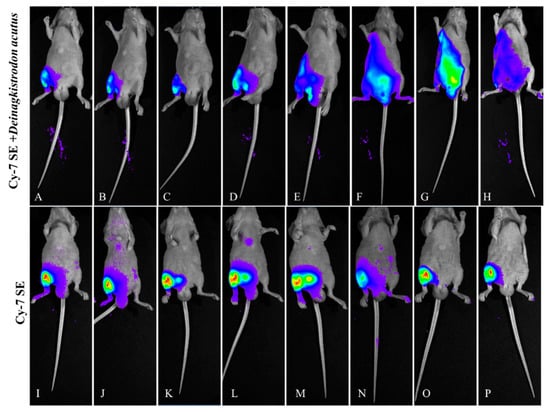
Figure 12.
Fluorescence changes in the supine position of mice injected with Cy7-SE-labeled Deinagkistrodon acutus venom. ((A–H): 5 min, 15 min, 30 min, 1 h, 3 h, 6 h, 12 h, 24 h; (I–P) are the same as (A–H)).
2.4.3. Prone Position Imaging (Figure 13)
The changes in the control group were consistent with those described above. The labeled venom group showed progressive renal accumulation: 1.62-fold higher renal intensity (4.436 × 109 photons/s/mm2) than control at 3 h, retaining 30.2% peak signal at 24 h.
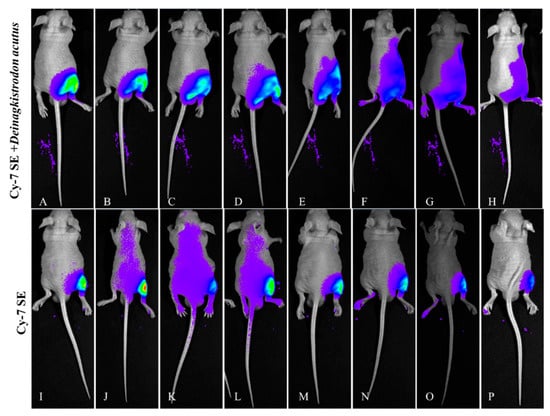
Figure 13.
Fluorescence changes in prone position of mice injected with Cy7-SE-labeled Deinagkistrodon acutus venom. ((A–H): 5 min, 15 min, 30 min, 1 h, 3 h, 6 h, 12 h, 24 h; (I–P) are the same as (A–H)).
2.4.4. Organ-Specific Fluorescence Dynamics of CY7-SE-Labeled Deinagkistrodon acutus Venom (Figure 14 and Figure 15)
Cardiac fluorescence exhibited significant elevation from 5 min to 3 h post-injection (peak: 5.35 × 108 photons/s/mm2, ΔFI = 51.2%, p < 0.05), followed by 8.2% clearance after 3 h, while hepatic fluorescence surged at 15 min (ΔFI = 53.3%, p < 0.05), peaking at 3 h (6.24 × 109 photons/s/mm2) with subsequent decay at 1.78%/h to <5% residual signal by 24 h. Concurrently, splenic fluorescence displayed transient monophasic enhancement exclusively at 3 h (ΔFI = 35.3%, 1.01 × 109 photons/s/mm2, p < 0.05), whereas pulmonary signals escalated significantly by 15 min (ΔFI = 121.2%, p < 0.05), peaking at 3 h (1.97 × 109 photons/s/mm2) yet retaining 47.8% residual intensity (1.57 × 109 photons/s/mm2, p < 0.05) at 24 h. Renal accumulation progressed continuously from 15 min to 3 h (ΔFI = 272.7%, 1.16 × 1010 photons/s/mm2, p < 0.05), followed by 40% decay (4.64 × 109 photons/s/mm2) during 3–6 h and stabilization at 28.8% peak intensity by 24 h, contrasting with diaphragmatic fluorescence that surpassed controls during 1–6 h (ΔFI = 59.6–49.2%, p < 0.05) before normalizing by 12 h (p > 0.05). Notably, cerebral signals manifested transient elevations at 1 h (ΔFI = 43.4%, 1.24 × 109 photons/s/mm2) and 3 h (ΔFI = 63.5%, 1.41 × 109 photons/s/mm2) (p < 0.05), indicative of intermittent neurovascular penetration.
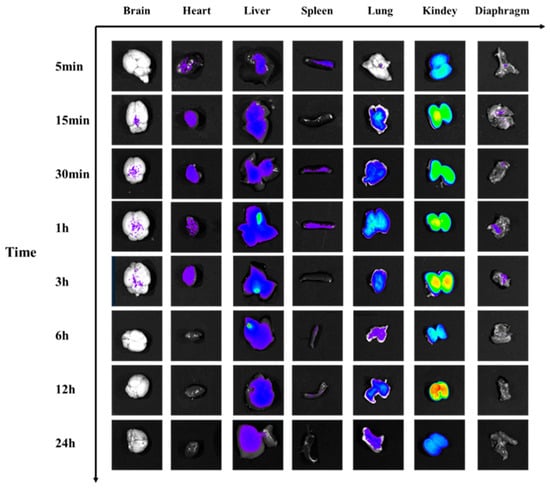
Figure 14.
Fluorescence changes in organs of mice injected with Cy7-SE-labeled Deinagkistrodon acutus venom.
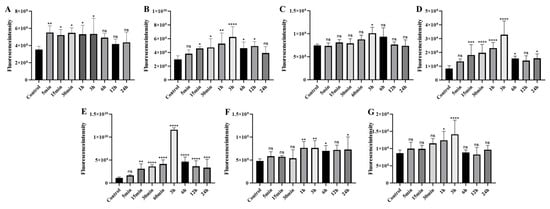
Figure 15.
Statistical analysis of fluorescence changes in organs of mice injected with Cy7-SE-labeled Deinagkistrodon acutus venom ((A): Heart (B): Liver (C): Spleen (D): Lung (E): Kidney (F): Diaphragm (G): Brain; n = 6, * p < 0.05, ** p < 0.01, *** p < 0.001, **** p < 0.0001, ns p > 0.05).
2.5. The Types of Toxins from Naja atra/Deinagkistrodon acutus Venom That Target Various Organs in Mice
Based on the previous results, we have determined that the strongest fluorescent signal of the labeled Naja atra venom and Deinagkistrodon acutus venom in the body occurs at 6 h and 3 h, respectively. We then detected the types of venom in the organs with high fluorescence accumulation, and the identification results are shown in the table below (Table 4). In the kidney tissue of the labeled Naja atra venom group, Acid phosphatase A2 and the Probable weak neurotoxin NNAM2 were identified. The Probable weak neurotoxin NNAM2 was also identified in both muscle and liver tissues. In the labeled Deinagkistrodon acutus venom group, eight types of venom proteins were identified across six tissues, which were classified into the metalloproteinase family, phospholipase family, and serine protease family. In the lung tissue, alkaline phosphatase and venom thrombin-like enzyme fragment were identified. In the liver tissue, venom thrombin-like enzyme, snake venom metalloproteinase Ac1, snake venom serine protease Dav-X, and venom thrombin-like enzyme were identified. In the brain tissue, venom thrombin-like enzyme was identified. In the diaphragm, three proteins were identified: thrombin-like enzyme 2, zinc metalloproteinase-integrin-like agkihagin, and zinc metalloproteinase-integrin-like acurhagin. In the spleen tissue, two venom proteins were identified: venom thrombin-like enzyme and zinc metalloproteinase-integrin-like agkihagin. Acid phosphatase A2 was detected in the kidney tissue.

Table 4.
Shotgun identified snake venom in the corresponding organs of labeled Naja atra/Deinagkistrodon acutus venom at the timepoint of fluorescence high enrichment in mice.
3. Discussion
Snakebite envenoming, classified by the World Health Organization (WHO) as a neglected tropical disease (NTD) (ICD-11 code: NE61, 12 September 2023) [], remains a critical global health challenge. While antivenom administration constitutes the standard therapeutic intervention, its clinical application—particularly regarding therapeutic window determination and dose optimization—still relies heavily on empirical clinical judgment. This underscores the imperative to delineate venom pharmacokinetics, including spatiotemporal distribution patterns and metabolic clearance dynamics, to establish evidence-based protocols for precision antivenom therapy.
Current research on snake venom tracking predominantly relies on radioisotope labeling and ELISA techniques, yet these methods exhibit notable limitations. The ELISA approach requires the preparation of highly specific anti-venom antibodies, whose development encounters dual technical barriers: firstly, antiserum production necessitates dependence on large animal immunization models (e.g., equine species); secondly, due to the multicomponent nature of snake venom (a complex system containing macromolecular proteins and small molecular peptides), antibodies struggle to achieve pan-specific recognition across the full protein spectrum, resulting in constrained detection sensitivity []. Radioisotope methodology is constrained by the short half-life characteristics of isotopes and stringent operational requirements (mandating specialized radiation protection zoning systems). This study innovatively employs Cy7-SE fluorescent labeling technology, achieving four groundbreaking technical advantages: ① real-time visual dynamic tracing ② radiation-free safe operation ③ 24 h prolonged tracking capability ④ picomolar-level detection sensitivity, thereby providing a revolutionary technical solution for toxicokinetic studies. This methodology successfully addresses the core deficiencies of conventional techniques, demonstrating significant methodological innovation value.
The dynamic distribution of snake venom in vivo can be characterized by a toxicokinetic bicompartmental model consisting of a rapid distribution phase (α-phase) and a slow elimination phase (β-phase) []. Intravenous injection data indicate that the half-life of the rapid distribution phase (t1/2α) typically ranges from 5 to 48 min, while the slow elimination phase half-life (t1/2β) extends from 48 min to 28 h [,,]. To simulate clinical envenomation pathology, experimental protocols predominantly employ intramuscular or subcutaneous injection routes, requiring particular attention to differential effects of absorption rate (Ka) and bioavailability (F) in non-intravenous administration []. Research reveals that intramuscular/subcutaneous injection of whole venom or monomeric toxins manifests a characteristic biphasic pattern—initial absorption period followed by elimination phase, yet only partial toxins enter systemic circulation: intramuscular bioavailability ranges from 4 to 81.5%, with subcutaneous administration approximating 60% [,,]. Notably, unabsorbed residual components (approximately 18.5–96%) from intramuscular whole venom injection may persistently localize at the administration site, with cytotoxins in cobra venom identified as key mediators of local tissue necrosis []. Furthermore, significant molecular weight heterogeneity (10–150 kDa) among protein components in crude venom leads to marked variations in distribution rates between different toxins. This multicomponent kinetic characteristic induces pronounced fluctuation in the overall distribution process of the venom [].
In this study, intramuscular injection of Cy7-SE-labeled venoms into murine hindlimbs coupled with small animal in vivo imaging revealed distinct biphasic kinetic profiles: Deinagkistrodon acutus venom (DAV) achieved multi-organ distribution within 3 h, whereas Naja atra venom (NAV) required 6 h for systemic dissemination. Pharmacodynamic tracing demonstrated DAV’s characteristic hemotoxicity—rapid systemic diffusion inducing hemorrhagic manifestations in major organs, consistent with clinical coagulopathy phenotypes. Conversely, NAV exhibited cytotoxicity—localized retention at injection sites causing tissue necrosis through cytotoxin-mediated pathological processes. Quantitative analysis showed 64.6% fluorescence intensity retention for NAV at 24 h post-injection, significantly higher than DAV’s 18.15%. This divergence originates from compositional differences: cytotoxins and metalloproteinases constitute 42.3 ± 5.1% of NAV versus 12.8 ± 3.6% in DAV, explaining their tissue-retentive necrotic effects. In contrast, DAV’s high expression of thrombin-like enzymes (67.2 ± 4.9%) and hemorrhagins (22.1 ± 2.7%) facilitated systemic spread, with subcutaneous ecchymosis area reaching 7.378 cm2 at 24 h—3.7-fold larger than NAV’s 1.996 cm2.
Organ-targeting kinetics were elucidated through in vivo imaging at eight timepoints: 0.083 h (5 min), 0.25 h (15 min), 0.5 h (30 min), 1 h, 3 h, 6 h, 12 h, and 24 h. DAV exhibited sequential organ colonization: heart (1 h) > liver = lungs = kidneys (3 h) > brain = diaphragm (6 h) > spleen (12 h). NAV progression followed: spleen = diaphragm (1 h) > lungs (3 h) > heart = liver = kidneys (6 h) > brain (12 h). Hemotoxic DAV rapidly translocated via capillaries to the heart, subsequently targeting vascular-rich organs (liver, kidneys, lungs). Cytotoxic NAV migrated through lymphatic systems to the spleen, with neurotoxins accelerating diffusion to respiratory hubs (diaphragm, lungs) before inducing multi-organ damage and BBB penetration. This systematic characterization establishes structure-activity relationships among venom types (hemotoxic vs. cytotoxic), bioactive component ratios (thrombin-like enzymes: 67.2% vs. 9.8%; neurotoxins: 4.1% vs. 38.7%), and organ-targeting sequences, providing theoretical foundations for differentiated snakebite therapeutics.
Venom thrombin-like enzymes are the second most abundant enzymes in snake venom, belonging to the S1 family of peptidases with serine endopeptidase activity. Their primary function is to disrupt the body’s hemostatic system, leading to fibrinogenolysis, fibrinolysis, platelet aggregation, thrombosis, and neurological disorders [,,,]. The metalloproteinase family is abundant in snake venom, predominantly comprising zinc-metalloproteinases. These enzymes can cause severe hemorrhage by interfering with coagulation or degrading basement membrane and extracellular matrix components [,]. For example, Zinc metalloproteinase-disintegrin-like acurhagin dose-dependently inhibits collagen-induced platelet aggregation, cleaves fibrinogen, and degrades fibronectin [,]. Acid phosphatase A2 exhibits multiple pathological effects including myotoxicity, edema, anticoagulation, hypotension induction, and presynaptic neurotoxicity [,] and exerts direct cytotoxicity on renal tubular cells []. Weak neurotoxins are small-molecule proteins demonstrated to be weak agonists of nicotinic acetylcholine receptors [].
In this study, we identified thrombin-like fragments in multiple tissues (brain, liver, spleen, lung, and diaphragm) of snakebite-infected mice, suggesting their potential involvement in both coagulation and fibrinolysis processes leading to hemorrhage. Concurrently, metalloproteinases were detected in diaphragm, liver, and spleen tissues, and their synergistic action with thrombin-like fragments is hypothesized to cause hemorrhage in these organs. The acid phosphatase A2 identified in kidney tissue may be a key factor causing edema in renal tubular epithelial cells. Furthermore, in another set of experiments, acid phosphatase A2 and a weak neurotoxin were detected in kidney tissue, injection site muscle, and liver. The latter is speculated to be related to neural signaling in these organs.
This investigation has several methodological constraints that warrant acknowledgment. Firstly, the pharmacokinetic profile of venom was not fully elucidated beyond its rapid biodistribution and organ-specific clearance, as systemic elimination kinetics over extended periods (e.g., >24 h metabolic degradation or excretory pathways) were not characterized. Secondly, limitations inherent to murine models and analytical methodologies impeded comprehensive toxin identification: Shotgun proteomics failed to detect low-abundance venom components in organs, while the absence of monospecific antibodies against individual toxins precluded immunohistochemical validation of spatially resolved venom speciation.
4. Materials and Methods
4.1. Major Experimental Materials
Lyophilized powders of Naja atra (Chinese cobra) venom and Deinagkistrodon acutus (hundred-pacer viper) venom were obtained from the Guangxi Medical University Snake Venom Research Institute and stored at −80 °C. CY7-SE was purchased from MedChemExpress (Jersey, NJ, USA). Methanol and acetonitrile (HPLC grade) were sourced from Merck (Darmstadt, Germany). Sodium pentobarbital was acquired from Sigma-Aldrich Co. LLC (Saint Louis, MO, USA). Ultrapure water was prepared using a Milli-Q water purification system from MilliporeSigma (Saint Louis, MO, USA). Gel filtration chromatography columns (Thermo Scientific, Waltham, MA, USA) and hematoxylin-eosin (H&E) staining kits were obtained from Solarbio Science & Technology Co., Ltd. (Hangzhou, China). Blood and serum analyses in mice were conducted using a veterinary-specific automated hematology analyzer and biochemistry analyzer (Mindray Bio-Medical Electronics, Shenzhen, China).
4.2. Animals and Experimental Design
All animal procedures were conducted in accordance with protocols approved by the Animal Ethics Committee of Guangxi Medical University (Approval No. SCXK [Gui] 2018-0003). Kunming mice and hairless mice (nu/nu strain) used for acute toxicity testing and small animal live imaging experiments were procured from the Experimental Animal Center of Guangxi Medical University, which holds institutional certifications for laboratory animal production and utilization (License No. SCXK [Gui] 2018-0003).
All mice were 4 weeks old and male. After obtaining the animals, they were housed together and assigned identification numbers. Mouse numbers were entered into SPSS 22.0 in ascending order, then randomly assigned to each group using random numbers. All mice were maintained under identical housing conditions, with no other factors controlled. All participants in the experiment were explicitly informed of the grouping during the randomization process. All analyses were based on the obtained data, with the survival rate analysis outcome being the survival status of mice after 24 h.
In the acute toxicity study, mice were divided into unlabeled Naja atra venom, labeled Naja atra venom, unlabeled Deinagkistrodon acutus venom, and labeled Deinagkistrodon acutus venom groups. Based on the LD50 values of Naja atra venom and Deinagkistrodon acutus venom, four concentration gradients were established: 1/2 LD50, LD50, 2 LD50, and 3 LD50. Each group comprised 6 mice, totaling 96 mice. Hematological and histopathological examinations were conducted on saline control mice, labeled Naja atra venom mice, and labeled Deinagkistrodon acutus venom mice. Each group included 6 mice, totaling 18 mice; however, mice that died due to toxin effects were excluded.
Real-time tracking of snake venom dynamics in mice was conducted across four groups: control, labeled Naja atra venom, labeled Deinagkistrodon acutus venom, and CY7-SE. Each group comprised six mice. For monitoring fluorescence changes in major organs, six mice per group were used. Mice that died due to toxicity were excluded. A total of 168 mice were utilized for this section. A total of 282 mice were used in this experiment.
4.3. Labeling and Characterization of Naja atra and Deinagkistrodon acutus Venoms
4.3.1. Labeling of Venoms
Lyophilized Naja atra and Deinagkistrodon acutus venoms (100 mg each) were reconstituted in 10 mL of physiological saline (0.9% NaCl). After overnight incubation at 4 °C, insoluble particulates were removed by centrifugation at 3000× g for 15 min. The supernatant was quantified via the Bradford protein assay. A CY7-SE working solution was prepared by dissolving 10 mg of CY7-SE in 400 μL of anhydrous dimethyl sulfoxide with vortex mixing. For labeling optimization, 1 mg of each venom protein solution was incubated with 2, 3, 4, 5, or 6 μL of the CY7-SE working solution under ambient light-protected conditions. The reaction mixtures were gently agitated every 30 min for 6 h, followed by storage at 4 °C for subsequent purification.
4.3.2. Optimization of Labeling Ratios and Separation of Free CY7-SE
Labeled venom proteins were purified using an ÄKTA pure HPLC system (Cytiva, Marlborough, MXG USA) equipped with a gel filtration column (Superdex 75 Increase 10/300 GL, Cytiva, Marlborough, MXG, USA). The mobile phase consisted of phosphate-buffered saline (PBS, pH 7.4) at a flow rate of 1 mL/min. Fluorescence detection was performed with excitation/emission wavelengths set at 740/800 nm. Chromatographic fractions corresponding to unbound CY7-SE (eluted in the trailing peaks) were discarded, while early-eluting peaks containing labeled venom proteins were collected and lyophilized.
To validate labeling efficiency and venom integrity, reconstituted labeled venoms were subjected to SDS-PAGE followed by Coomassie Brilliant Blue staining. Parallel fluorescence imaging of the gels was conducted using an IVIS Lumina XR live imaging system (PerkinElmer, Shelton, CT, USA) to confirm covalent conjugation of CY7-SE to venom proteins.
4.3.3. Toxicity Assessment of Labeled Venoms
Based on the median lethal dose (LD50) values of cobra (Naja atra) and five-step snake (Deinagkistrodon acutus) venom previously determined by our research team [], Kunming (KM) mice were administered the labeled venom via intramuscular injection in the leg at an LD50-equivalent dose. Blood samples were collected through the orbital sinus 12 h after injection, and comprehensive hematological analysis (complete blood count) and biochemical analysis (liver and kidney function indicators, muscle enzyme levels) were performed using an automated analyzer. Inject different concentrations of labeled venom and unlabeled venom (0.5 LD50–2 LD50) and observe the survival of mice after 24 h to assess changes in the acute toxicity of the labeled snake venom. Subsequently, all mice were euthanized.
Following euthanasia by cervical dislocation under sodium pentobarbital anesthesia (50 mg/kg, i.m.), major organs (heart, liver, spleen, lungs, kidneys) and target tissues (diaphragm, injection-site skeletal muscle, brain) were harvested. Tissue specimens were fixed in 10% neutral buffered formalin, paraffin-embedded, and sectioned at 4 μm thickness. Histopathological evaluation was performed using a standardized hematoxylin and eosin (H&E) staining protocol (Solarbio H&E staining kit, Beijing, China), including deparaffinization, rehydration, nuclear staining (hematoxylin), cytoplasmic counterstaining (eosin), dehydration, clearing in xylene, and permanent mounting with resinous medium. Representative photomicrographs at 200× magnifications were acquired using a digital slide scanner (Pannoramic MIDI, 3DHISTECH, Budapest, Hungary) coupled with CaseViewer software (v2.4).
4.3.4. Real-Time Visualization of Labeled Venom Biodistribution
Control mice received intravenous injections of free CY7-SE dye equivalent in mass to the labeled venom groups, while experimental groups were administered LD50 doses of Naja atra-CY7-SE or Deinagkistrodon acutus-CY7-SE conjugates. Longitudinal fluorescence tracking was performed using an IVIS Spectrum CT system (PerkinElmer, USA) with excitation/emission filters set at 740/770 nm. Whole-body imaging acquisitions were conducted at 15 min, 30 min, 1 h, 3 h, 6 h, 12 h, and 24 h post-injection under isoflurane anesthesia (2% v/v in oxygen).
Following euthanasia at each designated timepoint, major organs (heart, liver, spleen, lungs, kidneys) and neurovascular target tissues (brain, diaphragm, injection site) were excised for ex vivo fluorescence quantification. Tissue-specific fluorescent signals were measured as normalized radiant efficiency [(p/s/cm2/sr)/(μW/cm2)] using Living Image software (v4.7.2, PerkinElmer). Spatial-temporal biodistribution profiles were reconstructed through correlative analysis of in vivo dynamic imaging and ex vivo organ-level fluorescence intensities.
4.4. Shotgun Proteomics Was Employed to Identify Venom Toxin Species Within Snake Venom High-Accumulation Organs
4.4.1. Protein Extraction and Digestion
Total protein was extracted from the corresponding tissue according to the protein ex-traction kit protocol and quantified using the BCA assay kit (Thermo Scientific, Waltham, MA, USA). The extract was mixed with 5× loading buffer and subjected to electrophoresis. After Coomassie Brilliant Blue staining, the protein band at the target molecular weight was excised. The protein was digested with trypsin, desalted using a desalting column, vacuum-concentrated, and resuspended in 40 µL of 0.1% formic acid.
4.4.2. Fractionation
High pH reversed-phase method: Pierce high pH reversed-phase fractionation kit (Thermo Scientific, Waltham, MA, USA) was used to fractionate peptides of each sample into 6 fractions (or 10 fractions determined by project proposal) by an increasing acetonitrile step-gradient elution according to instructions.
4.4.3. LC-MS/MS Analysis
LC-MS/MS analysis was performed using two mass spectrometry systems: the Q Ex-active (Thermo Scientific, Waltham, MA, USA) coupled with the Easy nLC system, with an analysis duration of 65 min; and the TimsTOF Pro (Bruker, Würzburg, Germany) coupled with the Nanoelute system, with an analysis duration of 45 min. All peptide samples were separated using 0.1% formic acid as mobile phase A on a reverse-phase C18 analytical column. The Q Exactive employed a linear gradient elution with mobile phase B (84% acetonitrile, 0.1% formic acid) at a flow rate of 300 nL/min. The TimsTOF Pro utilized mobile phase B (99.9% acetonitrile, 0.1% formic acid). Both instruments operated in positive ion mode. The Q Exactive employed data-dependent acquisition, performing HCD fragmentation on the top 10 most abundant parent ions. The TimsTOF Pro acquired ion drift mass spectra within the m/z 100–1700 and 1/k0 0.75–1.35 ranges, followed by 10 cycles of PASEF MS/MS acquisition.
4.4.4. Identification and Quantitation of Proteins
MaxQuant: The MS raw data for each sample were combined and searched using the MaxQuant software (2.4.7.0) for identification and quantitation analysis. Related parameters and instructions are as follows Table 5:

Table 5.
Relevant Conditions for MaxQuant Database Retrieval.
Proteome Discoverer: The MS raw data for each sample were combined and searched using MASCOT engine (Matrix Science, London, UK; version 2.2) embedded into Proteome Discoverer 1.4 for identification analysis. Related parameters and instructions are as follows Table 6:

Table 6.
Proteome Discoverer Identification Conditions.
4.5. Statistical Analysis
Each distinct result section includes at least three mice. In this study, depending on the number of groups and homogeneity of variance, independent samples t-test or Welch’s t-test was used for two-group comparisons, while one-way ANOVA or Welch’s ANOVA was employed for multiple-group comparisons, with non-parametric tests as alternatives, when necessary, to ensure the robustness of the analysis. All data analysis was performed using GraphPad Prism 10. p < 0.05, p < 0.01, and p < 0.001 were considered to indicate significant differences.
Author Contributions
Conceptualization, M.L. and S.H.; methodology, S.H., M.X., N.J., Z.Z. and Q.J.; software, S.H., M.X. and N.J.; validation, S.H.; formal analysis, M.L. and S.H.; data curation, S.H., N.J., Z.Z. and Q.J.; writing—original draft, S.H., M.X. and M.L.; writing—review & editing, S.H., M.X. and M.L.; project administration, M.L., Y.Z. and X.L.; supervision, M.L., Y.Z. and X.L.; funding acquisition, M.L. All authors have read and agreed to the published version of the manuscript.
Funding
This work was supported by the National Natural Science Foundation of China (grant no. 81860344 to M.L., grant no. 82260386 to M.L.) and the Guangxi Natural Science Foundation (grant no. 2021GXNSFAA075025 to M.L.). The funders had no role in study design, data collection and analysis, decision to publish, or preparation of the manuscript.
Institutional Review Board Statement
We strictly abide by the standards of the Medical Ethics Committee of Guangxi Medical University, and submit ethical review reports on animal experiments (Approval No. SCXK [Gui] 2018-0003, 15 August 2021).
Data Availability Statement
The original contributions presented in this study are included in the article material. Further inquiries can be directed to the corresponding author(s).
Conflicts of Interest
The authors declare no conflict of interest.
References
- Eggert, S.; Kjærgaard, J.; Poulsen, A. [Snakebites]. Ugeskr. Laeger 2020, 182, V03200195. [Google Scholar]
- Gutiérrez, J.M.; Calvete, J.J.; Habib, A.G.; Harrison, R.A.; Williams, D.J.; Warrell, D.A. Snakebite envenoming. Nat. Rev. Dis. Primers 2017, 3, 17063. [Google Scholar] [CrossRef]
- He, D.; Hu, S.; Huang, Z.; Mo, C.; Cheng, X.; Song, P.; Li, Y.; Song, T.; Guan, Z.; Zhou, Y.; et al. Metabolomics analyses of serum metabolites perturbations associated with Naja atra bite. PLoS Neglected Trop. Dis. 2023, 17, e0011507. [Google Scholar] [CrossRef] [PubMed]
- Oliveira, A.L.; Viegas, M.F.; da Silva, S.L.; Soares, A.M.; Ramos, M.J.; Fernandes, P.A. The chemistry of snake venom and its medicinal potential. Nat. Rev. Chem. 2022, 6, 451–469. [Google Scholar] [CrossRef] [PubMed]
- Tasoulis, T.; Isbister, G.K. A Review and Database of Snake Venom Proteomes. Toxins 2017, 9, 290. [Google Scholar] [CrossRef] [PubMed]
- Iyaniwura, T.T. Snake venom constituents: Biochemistry and toxicology (Part 1). Vet. Hum. Toxicol. 1991, 33, 468–474. [Google Scholar]
- Sanhajariya, S.; Duffull, S.B.; Isbister, G.K. Pharmacokinetics of Snake Venom. Toxins 2018, 10, 73. [Google Scholar] [CrossRef]
- Shan, L.L.; Gao, J.F.; Zhang, Y.X.; Shen, S.S.; He, Y.; Wang, J.; Ma, X.M.; Ji, X. Proteomic characterization and comparison of venoms from two elapid snakes (Bungarus multicinctus and Naja atra) from China. J. Proteom. 2016, 138, 83–94. [Google Scholar] [CrossRef]
- Chen, P.C.; Huang, M.N.; Chang, J.F.; Liu, C.C.; Chen, C.K.; Hsieh, C.H. Snake venom proteome and immuno-profiling of the hundred-pace viper, Deinagkistrodon acutus, in Taiwan. Acta Trop. 2019, 189, 137–144. [Google Scholar] [CrossRef]
- Isbister, G.K.; Brown, S.G.; Page, C.B.; McCoubrie, D.L.; Greene, S.L.; Buckley, N.A. Snakebite in Australia: A practical approach to diagnosis and treatment. Med. J. Aust. 2013, 199, 763–768. [Google Scholar] [CrossRef]
- Gutiérrez, J.M.; Theakston, R.D.; Warrell, D.A. Confronting the neglected problem of snake bite envenoming: The need for a global partnership. PLoS Med. 2006, 3, e150. [Google Scholar] [CrossRef]
- Britt, A.; Burkhart, K. Naja naja cobra bite. Am. J. Emerg. Med. 1997, 15, 529–531. [Google Scholar] [CrossRef] [PubMed]
- Dobaja Borak, M.; Leonardi, A.; Požek, K.; Reberšek, K.; Podgornik, H.; Pirnat, A.; Trampuš Bakija, A.; Kranjc Brezar, S.; Trobec, T.; Žužek, M.C.; et al. Reversible Thrombocytopenia of Functional Platelets after Nose-Horned Viper Envenomation is Induced by a Snaclec. Thromb. Haemost. 2025, 125, 484–491. [Google Scholar] [CrossRef] [PubMed]
- Wang, W.; Chen, Q.F.; Yin, R.X.; Zhu, J.J.; Li, Q.B.; Chang, H.H.; Wu, Y.B.; Michelson, E. Clinical features and treatment experience: A review of 292 Chinese cobra snakebites. Environ. Toxicol. Pharmacol. 2014, 37, 648–655. [Google Scholar] [CrossRef] [PubMed]
- Bin Haidar, H.; Almeida, J.R.; Williams, J.; Guo, B.; Bigot, A.; Senthilkumaran, S.; Vaiyapuri, S.; Patel, K. Differential effects of the venoms of Russell’s viper and Indian cobra on human myoblasts. Sci. Rep. 2024, 14, 3184. [Google Scholar] [CrossRef]
- Cheng, C.L.; Mao, Y.C.; Liu, P.Y.; Chiang, L.C.; Liao, S.C.; Yang, C.C. Deinagkistrodon acutus envenomation: A report of three cases. J. Venom. Anim. Toxins Incl. Trop. Dis. 2017, 23, 20. [Google Scholar] [CrossRef]
- Thavornpradit, S.; Usama, S.M.; Lin, C.M.; Burgess, K. Protein labelling and albumin binding characteristics of the near-IR Cy7 fluorophore, QuatCy. Org. Biomol. Chem. 2019, 17, 7150–7154. [Google Scholar] [CrossRef]
- Korah, M.C.; Hima, S.P.; V, S.R.; Anil, A.; Harikrishnan, V.S.; Krishnan, L.K. Pharmacokinetics and Pharmacodynamics of Avian Egg-Yolk Derived Pure Anti-Snake Venom in Healthy and Disease Animal-Model. J. Pharm. Sci. 2022, 111, 1565–1576. [Google Scholar] [CrossRef]
- Ismail, M.; Aly, M.H.; Abd-Elsalam, M.A.; Morad, A.M. A three-compartment open pharmacokinetic model can explain variable toxicities of cobra venoms and their alpha toxins. Toxicon 1996, 34, 1011–1026. [Google Scholar] [CrossRef]
- Chen, L.; Chen, M.; Zhou, Y.; Ye, C.; Liu, R. NIR Photosensitizer for Two-Photon Fluorescent Imaging and Photodynamic Therapy of Tumor. Front. Chem. 2021, 9, 629062. [Google Scholar] [CrossRef]
- Pan, G.Y.; Jia, H.R.; Zhu, Y.X.; Wang, R.H.; Wu, F.G.; Chen, Z. Dual Channel Activatable Cyanine Dye for Mitochondrial Imaging and Mitochondria-Targeted Cancer Theranostics. ACS Biomater. Sci. Eng. 2017, 3, 3596–3606. [Google Scholar] [CrossRef]
- Camacho, X.; Machado, C.L.; García, M.F.; Gambini, J.P.; Banchero, A.; Fernández, M.; Oddone, N.; Bertolini Zanatta, D.; Rosal, C.; Buchpiguel, C.A.; et al. Technetium-99m- or Cy7-Labeled Rituximab as an Imaging Agent for Non-Hodgkin Lymphoma. Oncology 2017, 92, 229–242. [Google Scholar] [CrossRef] [PubMed]
- Karasev, M.M.; Stepanenko, O.V.; Rumyantsev, K.A.; Turoverov, K.K.; Verkhusha, V.V. Near-Infrared Fluorescent Proteins and Their Applications. Biochem. Biokhimiia 2019, 84 (Suppl. 1), S32–S50. [Google Scholar] [CrossRef] [PubMed]
- Zhao, H.; Zheng, J.; Jiang, Z. Pharmacokinetics of thrombin-like enzyme from venom of Agkistrodon halys ussuriensis Emelianov determined by ELISA in the rat. Toxicon 2001, 39, 1821–1826. [Google Scholar] [CrossRef] [PubMed]
- Guo, M.P.; Wang, Q.C.; Liu, G.F. Pharmacokinetics of cytotoxin from Chinese cobra (Naja naja atra) venom. Toxicon 1993, 31, 339–343. [Google Scholar] [CrossRef]
- Nakamura, M.; Kinjoh, K.; Miyagi, C.; Oka, U.; Sunagawa, M.; Yamashita, S.; Kosugi, T. Pharmacokinetics of habutobin in rabbits. Toxicon 1995, 33, 1201–1206. [Google Scholar] [CrossRef]
- Sim, S.M.; Saremi, K.; Tan, N.H.; Fung, S.Y. Pharmacokinetics of Cryptelytrops purpureomaculatus (mangrove pit viper) venom following intravenous and intramuscular injections in rabbits. Int. Immunopharmacol. 2013, 17, 997–1001. [Google Scholar] [CrossRef]
- Yap, M.K.; Tan, N.H.; Sim, S.M.; Fung, S.Y. Toxicokinetics of Naja sputatrix (Javan spitting cobra) venom following intramuscular and intravenous administrations of the venom into rabbits. Toxicon 2013, 68, 18–23. [Google Scholar] [CrossRef]
- Tan, C.H.; Sim, S.M.; Gnanathasan, C.A.; Fung, S.Y.; Tan, N.H. Pharmacokinetics of the Sri Lankan hump-nosed pit viper (Hypnale hypnale) venom following intravenous and intramuscular injections of the venom into rabbits. Toxicon 2014, 79, 37–44. [Google Scholar] [CrossRef]
- Serrano, S.M.; Maroun, R.C. Snake venom serine proteinases: Sequence homology vs. substrate specificity, a paradox to be solved. Toxicon 2005, 45, 1115–1132. [Google Scholar] [CrossRef]
- Vivas-Ruiz, D.E.; Sandoval, G.A.; Mendoza, J.; Inga, R.R.; Gontijo, S.; Richardson, M.; Eble, J.A.; Yarleque, A.; Sanchez, E.F. Coagulant thrombin-like enzyme (barnettobin) from Bothrops barnetti venom: Molecular sequence analysis of its cDNA and biochemical properties. Biochimie 2013, 95, 1476–1486. [Google Scholar] [CrossRef] [PubMed]
- Wu, W.; Guan, X.; Kuang, P.; Jiang, S.; Yang, J.; Sui, N.; Chen, A.; Kuang, P.; Zhang, X. Effect of batroxobin on expression of neural cell adhesion molecule in temporal infarction rats and spatial learning and memory disorder. J. Tradit. Chin. Med. = Chung I Tsa Chih Ying Wen Pan 2001, 21, 294–298. [Google Scholar]
- Ullah, A.; Masood, R.; Ali, I.; Ullah, K.; Ali, H.; Akbar, H.; Betzel, C. Thrombin-like enzymes from snake venom: Structural characterization and mechanism of action. Int. J. Biol. Macromol. 2018, 114, 788–811. [Google Scholar] [CrossRef] [PubMed]
- Iwanaga, S.; Takeya, H. Structure and Function of Snake Venom Metalloproteinase Family. In Methods in Protein Sequence Analysis; Imahori, K., Sakiyama, F., Eds.; Springer: Boston, MA, USA, 1993; pp. 107–115. [Google Scholar]
- Bjarnason, J.B.; Fox, J.W. Snake venom metalloendopeptidases: Reprolysins. Methods Enzymol. 1995, 248, 345–368. [Google Scholar] [PubMed]
- Wang, W.J.; Huang, T.F. Purification and characterization of a novel metalloproteinase, acurhagin, from Agkistrodon acutus venom. Thromb. Haemost. 2002, 87, 641–650. [Google Scholar] [CrossRef]
- Wang, W.J.; Shih, C.H.; Huang, T.F. Primary structure and antiplatelet mechanism of a snake venom metalloproteinase, acurhagin, from Agkistrodon acutus venom. Biochimie 2005, 87, 1065–1077. [Google Scholar] [CrossRef]
- Wang, Y.M.; Wang, J.H.; Tsai, I.H. Molecular cloning and deduced primary structures of acidic and basic phospholipases A2 from the venom of Deinagkistrodon acutus. Toxicon 1996, 34, 1191–1196. [Google Scholar] [CrossRef]
- Burke, J.E.; Dennis, E.A. Phospholipase A2 biochemistry. Cardiovasc. Drugs Ther. 2009, 23, 49–59. [Google Scholar] [CrossRef]
- Ozer, J.; Ratner, M.; Shaw, M.; Bailey, W.; Schomaker, S. The current state of serum biomarkers of hepatotoxicity. Toxicology 2008, 245, 194–205. [Google Scholar] [CrossRef]
- Poh, S.L.; Mourier, G.; Thai, R.; Armugam, A.; Molgó, J.; Servent, D.; Jeyaseelan, K.; Ménez, A. A synthetic weak neurotoxin binds with low affinity to Torpedo and chicken alpha7 nicotinic acetylcholine receptors. Eur. J. Biochem. 2002, 269, 4247–4256. [Google Scholar]
Disclaimer/Publisher’s Note: The statements, opinions and data contained in all publications are solely those of the individual author(s) and contributor(s) and not of MDPI and/or the editor(s). MDPI and/or the editor(s) disclaim responsibility for any injury to people or property resulting from any ideas, methods, instructions or products referred to in the content. |
© 2025 by the authors. Licensee MDPI, Basel, Switzerland. This article is an open access article distributed under the terms and conditions of the Creative Commons Attribution (CC BY) license (https://creativecommons.org/licenses/by/4.0/).